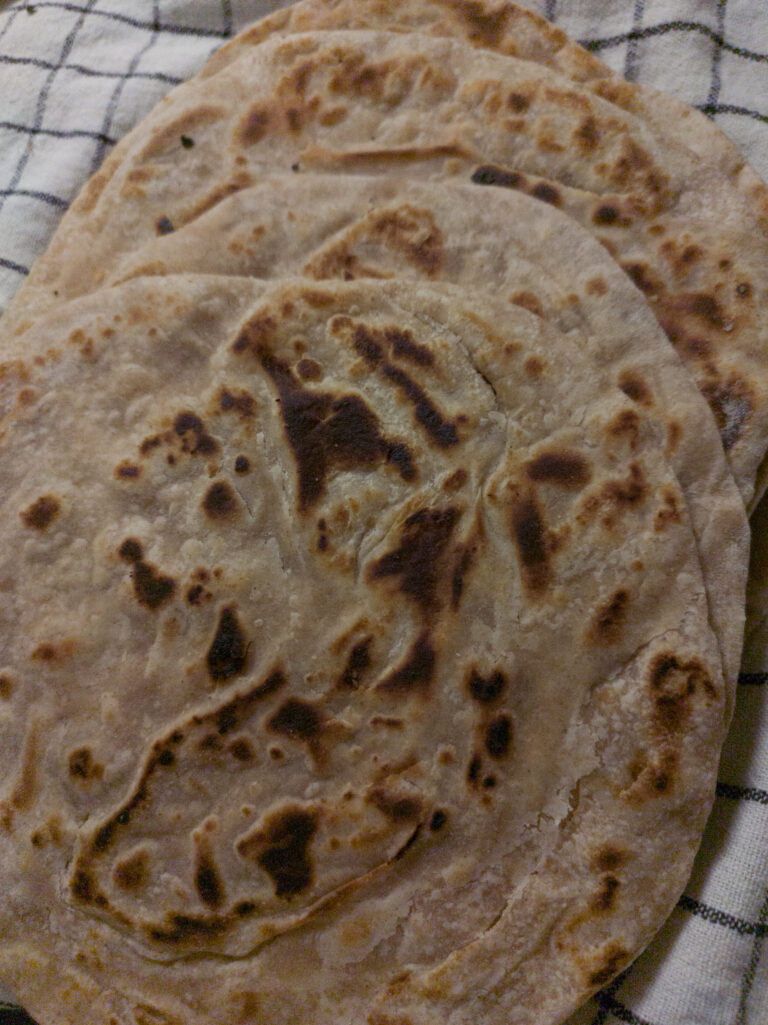The word Chapati is derived from the word ‘chapat’ in the Hindi language which translates to ‘slap’ in English. The name refers to the way the Chapati was traditionally made – by slapping the dough between both hands to form a thin and uniform round shape. Chapati has been a staple food in South Asia for centuries and continues to be so till this day. However, the origins of Chapati aren’t as clear as day as there are several claims of how Chapati came to be.
One of the earliest references to Chapati can be found in the Indus Valley Civilization, which flourished in the region that now encompasses modern-day India and Pakistan. However, some also claim that chapati was introduced by Persian travellers or even originated from East Africa.
Regardless of its origins, Chapati has stood the test of time and is cherished by many for its simplicity and versatility. It’s a bread that transcends borders and cultures, and has become an integral part of South Asian cuisine. From the warm and inviting aroma that fills the kitchen to the delight of tearing off a piece to dip into a flavorful curry – Chapati evokes a sense of comfort for many in South Asia.
NOTES ON CHAPATI
Atta flour vs other types of flour
Atta flour is the preferred flour for making Chapati – because of its high gluten content that provides elasticity to the dough without making it too tough. Additionally, the stone-ground milling process of atta flour gives it a nutty and naturally sweet flavour and aroma. Atta flour has a slightly coarser texture which helps the dough to absorb water evenly, preventing the chapati from becoming too soft or sticky. You can find atta flour at most local Indian stores, but if it’s not available, you can substitute it with whole wheat flour or all-purpose flour. However, as someone who has made chapati with all three types of flour, I can fully attest that atta flour is the only type of flour that can give you that authentic distinct Chapati flavour.
Ghee or Butter
Ghee and butter have some significant differences. Ghee is a type of clarified butter made by heating butter to remove water and milk solids, thus, giving it a higher smoke point and a rich, nutty flavour which compliments the Chapati well. On the other hand, butter is made from churning cream and has a more creamy, buttery flavour with lower smoke point and contains milk solids and water. Ghee is commonly used as a cooking oil and an ingredient to making condiments, while butter is a spread, baking ingredient, and flavouring agent. My personal recommendation would be to use ghee for this recipe, however, if it’s not available to you, substitute it with butter instead.
Milk
If you prefer not to use milk, substituting it with really warm water can also help achieve that soft and tender texture. Instead of using the 100 ml water and 82 ml milk called for in the recipe, you can try using 182 ml of really warm water.
STEPS ON MAKING CHAPATI
Making Chapati from scratch can sometimes be overwhelming for first-timers, but trust me, once you try this recipe, you’ll be eager to make it again and again. Let’s get buzzin’:
Chapati:
- Atta flour
- All – purpose flour
- Ghee / Butter
- Whole Milk
- Water
- Salt
In a large mixing bowl, combine atta flour and salt. Using clean hands, mix the ingredients together until the atta flour and salt are evenly distributed.
Next, add water and continue mixing until the flour starts to form small clumps.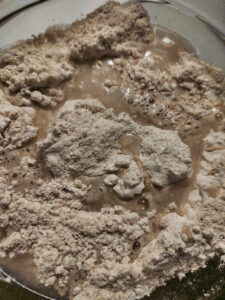
Then, add milk and continue to mix until the dough begins to come together. The dough is expected to be a bit sticky at this point.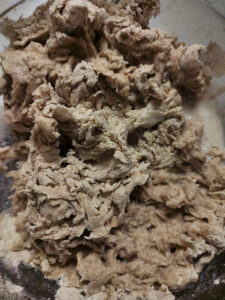
Now it’s time to add the ghee and start kneading the dough.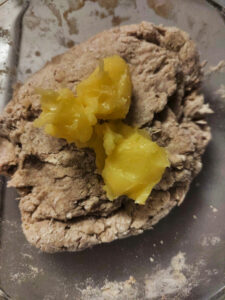
As you knead, you’ll notice the dough becoming smoother and less sticky. Keep kneading for a good 3 – 4 minutes.
Cover with a slightly damp kitchen towel or paper towel to prevent it from drying out, and set it aside for 30 minutes. After the dough has rested, knead it again for 1 minute and divide it into 9 dough balls. Each ball should weigh around 60-63 grams. Once you’ve formed the dough balls, set them aside.
Sprinkle some all-purpose flour on your rolling board or working surface and place a dough ball on it. Sprinkle some more flour on top of the ball and start rolling it out. Using a rolling pin, roll the dough ball horizontally once, and then diagonally to the left and right – each once. Flip the dough and repeat the process until the dough is about 6-7 inches in diameter.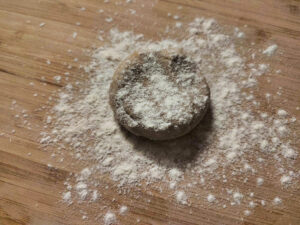
If you’d like a simple chapati and not a flaky one, you can stop here. Repeat the process with the remaining dough balls and then proceed to cooking them. However, if you’d like to make flaky chapatis, continue to the next step.
Spread a teaspoon of ghee or butter all over the rolled-out dough.
Then, roll it up horizontally until it forms a long, thin tube.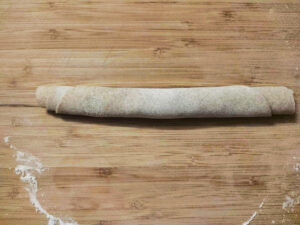
Twist the tube and then roll it into a coil, tucking the loose end underneath the coil. To prevent the coil from uncoiling, ensure that it is tightly wound. Repeat the process with the remaining dough balls.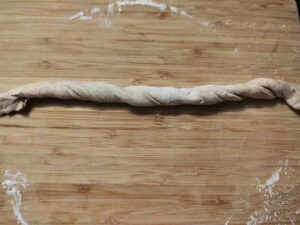

Again, sprinkle your rolling board or working surface with all-purpose flour, then place the coiled dough on it and sprinkle some more flour on top. Using a rolling pin, proceed to roll the dough out horizontally once, flipping it over, rotating it clockwise and roll again – repeat these steps until it reaches a diameter of approximately 5 inches.
Heat a flat pan on medium-high heat until it’s hot but not smoking. Place the first chapati on the pan and cook it for 2 minutes. You’ll see the chapati start to puff up or form hot pockets.
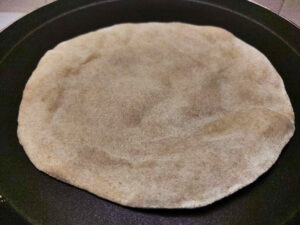
Flip it over and spread half a teaspoon of ghee on it. After another 2 minutes, flip it again and spread half a teaspoon of ghee on the other side. Then, flip it again for one final time and after 20 seconds, remove it from heat and transfer it to a plate.
While the first chapati is cooking, roll out the second one. Repeat the process until all chapatis are cooked. Keep the cooked chapatis warm by covering them with a dry kitchen towel until you’re ready to serve them.
Have your soft homemade chapati warm with your favourite curry, or turn them to a delicious wrap.
Enjoy!

Chapati
- PREP TIME: 40 min.
- COOK TIME: 40 min.
- TOTAL TIME: 80 min.
- YIELD: 9 servings
DIFFICULTY:
INGREDIENTS
- 367 grams of Atta flour
- 100 ml of Water
- 82 ml of Whole Milk
- 12 grams of Ghee (room temperature)
- A pinch of Salt
- 19.35 grams of Ghee (room temperature) for topping
INSTRUCTIONS
- In a mixing bowl, combine atta flour and salt.
- Mix the ingredients with clean hands until evenly distributed.
- Add water and continue mixing until small clumps form.
- Add milk and mix until the dough comes together.
- Add ghee and knead for 3-4 minutes until the dough becomes smoother.
- Cover the dough with a damp towel and let it rest for 30 minutes.
- Knead the dough again for 1 minute and divide into 9 dough balls.
- Sprinkle flour on a rolling board and using a rolling pin, roll each ball into a 6-7 inch diameter circle. For normal chapatis, stop here and proceed to step 10. For flaky chapatis, continue to step 9.
- To make flaky chapatis, spread ghee on the rolled-out dough, roll it into a tube, and twist it before rolling it into a coil.
- Sprinkle flour on a rolling board and using a rolling pin, roll out the coiled dough horizontally, rotate and roll – repeating until it’s 5 inches in diameter.
- Heat a flat pan and cook the chapati for 2 minutes on each side, spreading ghee on each side.
- Roll out the next chapati while the previous one cooks and repeat the steps.
- Serve warm with your favourite curry or use as a wrap.
- Enjoy!
NUTRITION FACTS
Total Fat: 4.6 mg
Sodium: 19.71 mg
Dietary Fiber: 2.37 mg
Protein: 4.87 g
Vitamin C: 0 mg
Cholesterol: 6.1 mg
Carbohydrates: 27.39 g
Sugars: 1.14 g
Vitamin A: 32.83 mcg
Iron: 0 mg
Daily values based on a 2,000 calorie diet.
